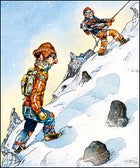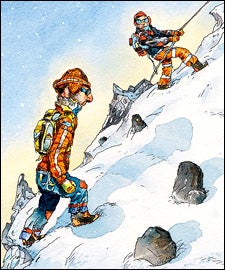SO THERE I WAS, climbing Mount Everest with what might fairly be described as one righteous stiffy. Not that I was particularly excited about the climbing just the opposite: I was nervous and felt like crap, hence my decision to pop a Viagra, which purportedly would make me feel better and climb faster. I was fit enough, but that hardly ensured success. My goal was to make it to Everest’s North Col. At 23,182 feet, it’s well shy of the 29,035-foot summit but more than 5,000 vertical feet higher than I’d ever been before.
Lab Rat: Viagra at altitude

Viagra has been in largely experimental use among mountaineers for a few years now, mostly for cases of high-altitude pulmonary edema, a dangerous condition in which the lungs fill with fluid. Viagra’s active ingredient, sildenafil citrate, has the impressive (and, to some, life-changing) ability to prompt blood flow to specific parts of the body, including the genitals, lungs, and brain. It has also been shown to increase aerobic endurance at elevation. In 2004, German researchers conducted a study using mountaineers and trekkers who spun stationary bikes at Nepal’s 17,600-foot Everest Base Camp in which sildenafil was one of the first drugs found to actually improve cardiovascular performance at altitude.
For the record: I had never tried Viagra, at any elevation. (I swear!) I worried that such “off-label” use of the drug might backfire and monkey-wrench my climb, so I ran my Viagra idea past Geoffrey Tabin, a physician, former world-class mountaineer, and current chairman of the medical committee for the American Alpine Club.
“Viagra! Ha!” he said. “OK, sure. It probably won’t hurt, but it may not work, er, prophylactically, if that’s what you’re after. Diamox will probably do the most for you. Also, be careful: The yaks might start looking pretty cute around week four.”
By the time I pulled into the 16,995-foot base camp on the Tibetan side of Everest, where I joined a large commercial expedition run by Himalayan Experience, I was toting a portable pharmacy. But before I started dosing myself, I consulted the team medic, Monica Piris. The 32-year-old ER doc was built like a ballerina and had silky brown hair that fell to her waist. The men in camp would come up with almost any excuse to visit her. Chapped lips. Hangnail. Viagra.
“That’s just another trend,” she said about my little blue pill. “The thing about high-altitude meds is, there is just so little research, most claims are almost entirely inconclusive. What works for one person might not work at all for someone else.”
It’s important to note here that Viagra was just a minor part of my overall strategy to prevent altitude sickness. More important players included Diamox, ginkgo biloba, diligent hydration, and good old ibuprofen though on arrival I learned that aspirin is recommended. (For more on high-altitude meds, check out .) Diamox, a.k.a. acetazolamide, was my go-to drug, and it worked great, though very differently from Viagra. Diamox hastens acclimatization by forcing your kidneys to excrete bicarbonate, which stimulates your lungs to take in more oxygen. Translation: You pee a lot. I started on 250 milligrams twice a day about 24 hours before I moved to a higher elevation and found that I acclimatized with only minor discomfort within a couple of days. Viagra, by comparison, doesn’t alter blood chemistry, just blood flow, and I first dabbled with it on an acclimatization hike at base camp. It didn’t help much; I was still huffing desperately up hills, and I spent the night with a kickstand that wasn’t exactly conducive to a good night’s sleep.
Twenty-one days after arriving at Everest, I successfully made it up to the North Col. It was a tough but Viagra-free ascent. Feeling inspired, and still curious to see if the drug might in fact provide a nonsexual performance jolt, I decided to give it one last try on my descent from advance base camp to base camp, a roughly 12-mile, 4,000-vertical-foot slog over rocky terrain. I figured it was safe enough, since I was descending now, not climbing.
Viagra might have helped me hike faster I felt pretty good, actually but the awkward reality was that it simply didn’t matter. Whether I made it down in four hours or eight was irrelevant compared with the useless and uncomfortable trekking pole in my pants. This is stupid, I thought. What a waste. I made it to camp later that afternoon, well short of any speed record. If I ever come back to Everest, I thought, the Viagra is staying at home, where someday far in the future it might do some real good.
��


